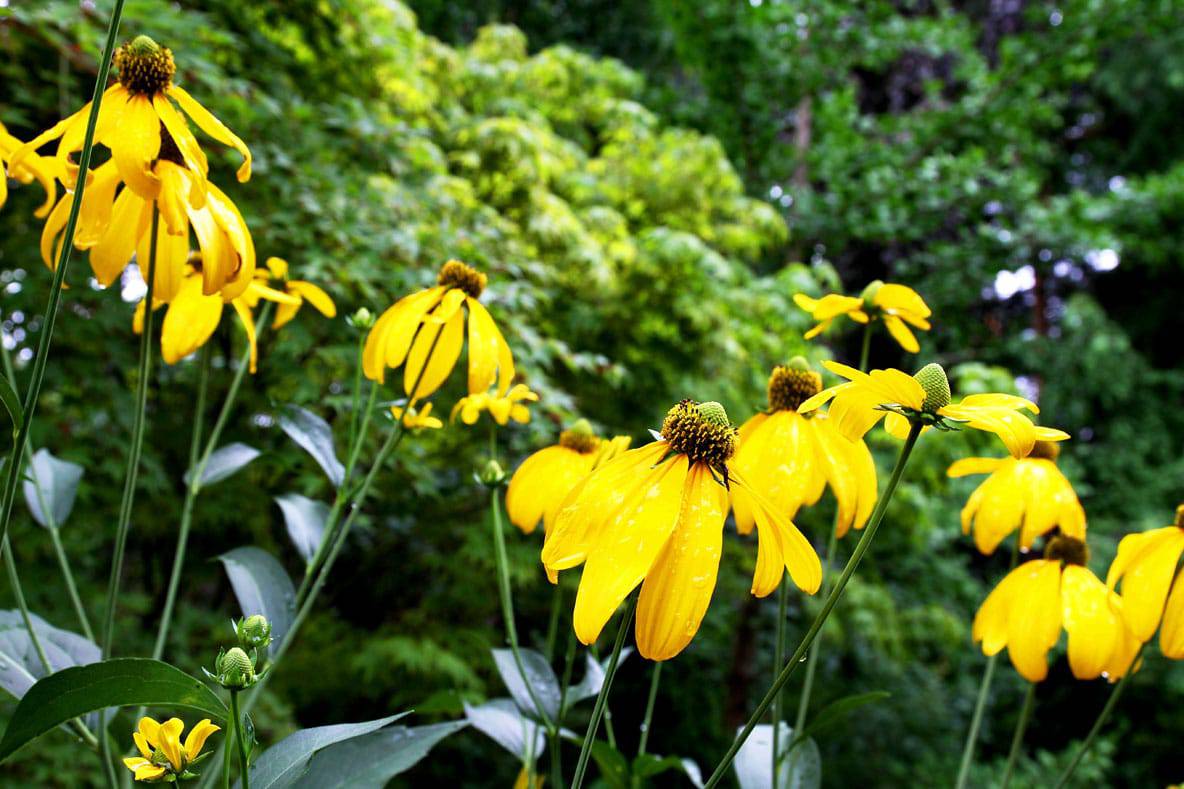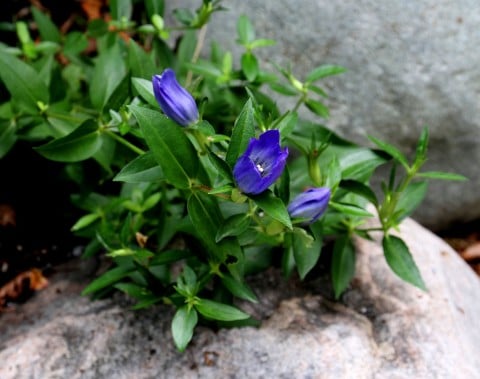
The weeks from the end of summer to the first frost are a rich season for late-blooming perennials. I don’t have nearly enough of these plants that flower when temperatures and soil begin to cool, and daylight shortens. But the few I do grow provide real pleasure and spur me on to purchase a wider selection.
There are many forms of coneflowers in the rudbeckia clan, all with reflexed yellow petals and brown, cone-shaped disks. They’re long-blooming and pest-free, and require little care beyond watering each week if there’s no rain. My favourite is Autumn Sun coneflower (Rudbeckia laniciata ‘Herbstsonne’ syn. R. nitida ‘Herbstsonne’, Zone 3), now more than six feet (1.8 m) tall in my garden. Careful watering has resulted in their lofty stems; they have a natural stiff and erect posture, with no flopping. The plant’s height is vulnerable to wind, and I find it useful to provide a support (the deck banister), and loop a loose piece of hemp twine around the cluster of stems to prevent them from being bent over.
‘Herbstsonne’ coneflower starts blooming in my garden about the middle of July and carries on into September. The plant has generous side shoots that produce lots of flowers all through the upper half of the plant. If allowed to stand into winter, the seed heads are charmingly snow-capped. The flowers are prodigious nectar producers, and enthusiastically attended by small bees and miniature wasps from dawn to dusk. These little fellows are entirely indifferent to curious gardeners and allow close observation. Cruising the garden one morning at dawn, I was surprised to see little bees sleeping overnight on the plant, hiding themselves deep under the reflexed petals where they attach to the central disk. They slumbered on until the first direct sunlight began to warm the petals and stimulate the day’s nectar production. Such dedication!

Japanese and willow gentians
One good reason for joining a plant society (I belong to the Ontario Rock Garden and Hardy Plant Society) is the opportunity to discover new plants and learn how to grow practically anything. For years I thought gentians were too temperamental for my rough-and-tumble garden, but plant society members set me straight on some of the easiest gentians to grow. Currently blooming is Japanese gentian (Gentiana scabra, Zone 5); it’s in bright light on a slight slope next to some stone steps. It has 10- to 12-inch (25- to 30-cm) stems with the signature gentian-blue bells with white or grey throat markings. You don’t need a lot of these flowers to attract attention!
Although Japanese gentian is a beautiful plant with pride of place in my front bed, the real treasure is a small clump of willow gentian (G. asclepiadea, Zone 5), around the corner in the air-conditioner garden. This most graceful arching gentian is in heavy bud and my hope is that it will open in the coming week and remain in flower into September. The graceful stems travel in an arc, with their sleek flower buds prominently displayed on the upper side of the stems. My willow gentian grows in shade, with stems about 18 inches (45 cm) long, and would be larger in brighter light. The combination of graceful architecture and cobalt blue flowers is like too much happiness. When it’s in bloom, I keep slipping around the corner to make sure it’s still there.
Japanese and willow gentians are happy in light shade or part sun, with rich soil, consistent moisture and reliable drainage. I don’t know why anyone would want a gentian to be anything but blue; still, there is a wine-red gentian (G. scabra ‘Toki-rindo’) that’s quite appealing. I just might need to investigate that.
Planning for spring bulbs
Dare I mention that it’s time to be thinking of your spring bulb purchase? No one wants to let go of summer, but it’s worth trying to remember how the garden looked last spring, and where there were empty sections that might benefit from a display of narcissus or tulips. If only I would place markers where the bulbs are buried, make a map of the beds or keep a better journal of what bulbs are already planted—but the gardening life is busy, and I do more chasing after events and not enough planning ahead.
I do remember saying to myself that I need more crocus. I’m greedy in spring and want to see big bursts from bunched snow crocus, the early species that bloom even before the snow is gone. I was also disappointed that not enough daffodils returned, and I definitely need more ‘February Gold’, a small narcissus that comes out in March. I had some very double narcissus that were so top heavy with clustered petals they toppled over and required staking. (I don’t want any more of them, thank you!) I’d rather plant trumpets like ‘Ice Follies’, with a white perianth and frilled yellow cup, and the scented poet’s daffodil (Narcissus poeticus var. recurvus), with recurved white petals and a striking yellow-red eye. Maybe it’s time to make a statement with thick clumps of classic big trumpets, like yellow ‘Dutch Master’, with more flowers per stem and reliable return for several years. I’ll need to think about this more, and look through the print and online catalogues. Time marches on.

Hi Rhonda (Aug. 13),
My ‘Herbstsonne’ has quite a varied community of buzzing visitors. We’re photographing them; nice to remember in winter.
— Judith
I like Herbstsonne growing under my second floor window. It brings the blooms…and butterflies and bees up close for observation.